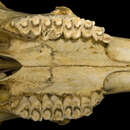Biology
provided by Arkive
Adult male waterbuck establish territories (3), which they guard from other males through displays and combat (4), using their prominent horns. Female and young waterbuck form herds of up to 30 individuals, which move freely through a number of male territories (3). Young males may form bachelor herds, until the opportunity arises to usurp an adult male from his territory (3). The strong, musky scent of waterbucks (3), caused by the oily secretion that coats the fur, is particularly pungent in males (5), and enables them to find other waterbuck. Unfortunately, this useful means of detection also makes them more vulnerable to being found by predators such as lions and hyenas (2).
As waterbucks roam around their range, they graze on a variety of grasses, which is unusually high in protein. This diet is supplemented with reeds, rushes (5), and even sometimes fruits, particularly when green grass is scarce (2). Waterbucks drink an unusually large amount of water for an antelope, hence the reason why they are never found too far from a water source (5).
During the mating season, adult males attempt to hold females as they wander through their territory, for mating (3). The gestation period lasts for over eight months, and the female gives birth to a single young, which remains hidden in vegetation for at least the first two weeks of life (2). After this period, the calf begins to join its mother and the herd (3), the mother's raised tail serving as a signal to follow (2). At the age of six months the young is weaned. Female waterbuck reach maturity at about three years of age (3), while males leave their mother's herd at about eight or nine months to join a bachelor herd (4), but are unable to compete for their own territory until five or six years old (2) (3). Waterbuck are known to live for up to 18 years (2).
Conservation
provided by Arkive
This shaggy-haired antelope thankfully remains widespread in numerous protected areas throughout its range (2) (6), such as Moukalaba Reserve in Gabon and 'W' National Park in Niger (6). However, even within these areas, illegal hunting and habitat degradation can remain a problem, and thus in many countries, the survival of the waterbuck relies on the continuation and improvement of effective protection of these parks and reserves (6).
Description
provided by Arkive
This rather shaggy-haired antelope is noted for its association with water and its strong musky scent (3). Its coat of coarse hair ranges in colour from grey-brown to reddish (3), with darker legs (2). The face is marked with white around the nose, mouth, above the eyes and on the throat (3). The short, rounded ears are white on the inside and black on the edges and tips (2) (3). The males bear long, heavily-ridged horns, extending back from the head and then sweeping forward (3), reaching up to 99 centimetres in length (2). Two subspecies of the waterbuck are recognised, which can be easily distinguished by the obvious pattern on their rear; a broad, white ring encircles the rump of the ellipsen waterbuck (Kobus ellipsiprymnus ellipsiprymnus), while the Defassa waterbuck (Kobus ellipsiprymnus defassa) has a solid white patch on its rump (2) (3).
Habitat
provided by Arkive
The waterbuck inhabits savannas and woodland where, as its name suggests, it is always within reach of permanent water (2). It favours areas where cover, in the form of woods or thickets, lies adjacent to open grassland suitable for grazing (3).
Range
provided by Arkive
The ellipsen waterbuck occurs in south-east Africa, east of the Great Rift Valley, while the Defassa waterbuck is found west of the Great Rift Valley, ranging from Ethiopia west to Senegal (2) (3).
Status
provided by Arkive
Classified as Lower Risk / Conservation Dependent (LR/cd) on the IUCN Red List 2007. Subspecies: Kobus ellipsiprymnus ellipsiprymnus (ellipsen or common waterbuck) and Kobus ellipsiprymnus defassa (Defassa waterbuck) are both classified as Lower Risk / Conservation Dependent (LR/cd) on the IUCN Red List 2007 (1).
Threats
provided by Arkive
The waterbuck has been eliminated from many areas within its large range (2), and is threatened in many other regions by hunting for food, competition with cattle for grazing, and the loss of suitable habitat to human settlements (1) (6).

